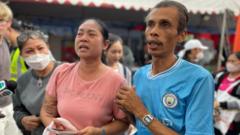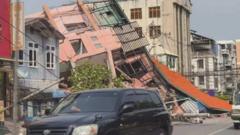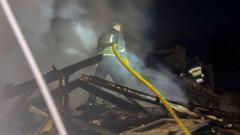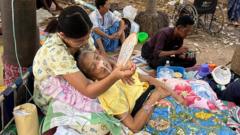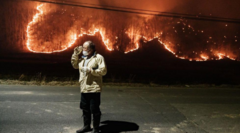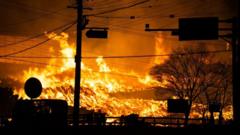As wildfires rage across South Korea's southeastern regions, at least 18 individuals have lost their lives, and 19 more have sustained injuries, according to recent updates from the Ministry of the Interior and Safety. Acting President Han Duck-soo described this disaster as "rewriting the record books for the worst wildfires in our nation's history." Over 23,000 residents have been evacuated, with significant destruction to heritage sites, including the loss of a 1,300-year-old Buddhist temple.
South Korea Faces Historic Wildfire Tragedy as Death Toll Rises
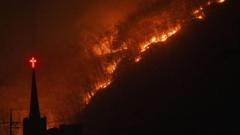
South Korea Faces Historic Wildfire Tragedy as Death Toll Rises
A crisis unfolds as South Korea battles unprecedented wildfires, with tragic consequences for communities.
A firefighting helicopter tragically crashed in Uiseong County, leading to an ongoing investigation. The fires have prompted the mobilization of thousands of firefighters and approximately 5,000 military personnel, alongside support from U.S. military helicopters stationed nearby. This marks a significant escalation, as the national fire agency has raised the alert to the highest possible level for the first time this year.
Wildfires are relatively rare in South Korea, but this series of blazes has already claimed more lives than any previous incident. The destruction spans approximately 17,000 hectares of forest, ranking this disaster among the most extensive in the country's history.
One of the most notable losses is the Gounsa Temple, established in 618 AD, which stood as one of the largest and most culturally significant temples in the area. Acting President Han lamented the conditions hampering firefighting efforts, particularly the lack of rain, specifying that current weather forecasts predict minimal precipitation.
There has been a notable uptick in wildfire occurrences this year, attributed to drier than average weather patterns, with a staggering 244 incidents reported already in 2023, a 2.4 times increase from the previous year's similar timeframe. The government has pledged to tighten regulations regarding illegal burning, one of the primary catalysts for such blazes, and to enhance preparedness strategies moving forward.
The wildfires initially ignited in Sancheong County last Friday and have since spread to adjacent cities, underscoring the urgency of addressing the environmental conditions that contributed to this crisis.
Wildfires are relatively rare in South Korea, but this series of blazes has already claimed more lives than any previous incident. The destruction spans approximately 17,000 hectares of forest, ranking this disaster among the most extensive in the country's history.
One of the most notable losses is the Gounsa Temple, established in 618 AD, which stood as one of the largest and most culturally significant temples in the area. Acting President Han lamented the conditions hampering firefighting efforts, particularly the lack of rain, specifying that current weather forecasts predict minimal precipitation.
There has been a notable uptick in wildfire occurrences this year, attributed to drier than average weather patterns, with a staggering 244 incidents reported already in 2023, a 2.4 times increase from the previous year's similar timeframe. The government has pledged to tighten regulations regarding illegal burning, one of the primary catalysts for such blazes, and to enhance preparedness strategies moving forward.
The wildfires initially ignited in Sancheong County last Friday and have since spread to adjacent cities, underscoring the urgency of addressing the environmental conditions that contributed to this crisis.

